In August 2008, while the world was fixated on the Summer Olympics in Beijing, a Russian invasion force comprised of hundreds of Russian tanks and armored vehicles passed through the Roki tunnel on theRussian–Georgian border. At the time, Russian troops got within miles of the Republic of Georgia’s capital city of Tbilisi and even bombed the civilian airport there. Hostilities were finally brought to an end after a Six Point Ceasefire Agreement was brokered by then-French President Nicolas Sarkozy. Almost a decade later, thousands of Russian troops occupy Abkhazia and the region around Tskhinvali, the so-called capital of South Ossetia,[REF] which together equal 20 percent of Georgia’s internationally recognized territory. If a foreign army occupied the equivalent one-fifth of the contiguous U.S., it would be comparable to all land west of the Rocky Mountains. Russia invaded Georgia, not the other way around. Russia is the aggressor, and Georgia is the victim.
Georgia is a staunch U.S. ally and has sacrificed greatly in places like Afghanistan, where it is the largest non–North Atlantic Treaty Organization (NATO) troop contributor and has suffered the most troops killed in action on a per capita basis. Georgia’s location in the South Caucasus on the Black Sea is strategically important for the U.S. for a number reasons, be they economic, trade-related, concerning the transit of energy to Western Europe, or for military and security reasons. Since it regained independence in 1991 after the break-up of the Soviet Union, Georgia has been a beacon of hope in an otherwise turbulent region. It has seen successive peaceful transfers of power in open and free elections. It has embraced economic reforms to liberalize its economy. It has sought a deeper relationship with transatlantic organizations.
The year 2018 is an important year for the U.S.–NATO–Georgian relationship. Not only does it mark the 10th anniversary of Russia’s military aggression against Georgia, it also marks the 10th anniversary of NATO’s promise to Georgia of eventual membership in the Alliance during the Bucharest Summit. Furthermore, the NATO Summit planned for July 2018 in Brussels offers the Alliance a chance to take the NATO–Georgia relationship to a new level of closeness, while keeping Georgia firmly and speedily on the path to full membership. Also important, 2018 will be the year that Georgia finally receives the long-sought Javelin anti-tank missile, marking a step forward in the U.S.–Georgia bilateral relationship.
In order to advance U.S.–Georgian relations, the U.S. must, among other things noted in the “Deepening the Relationship” section of this Special Report, continue to be an advocate for Georgia’s eventual membership in NATO, continue to strengthen the bilateral military relationship with an energized focus on territorial defense, bolster U.S. presence in the Black Sea, and continue to pressure Russia to end its illegal occupation of Georgian territory and to abide by the 2008 Six Point Ceasefire Agreement.
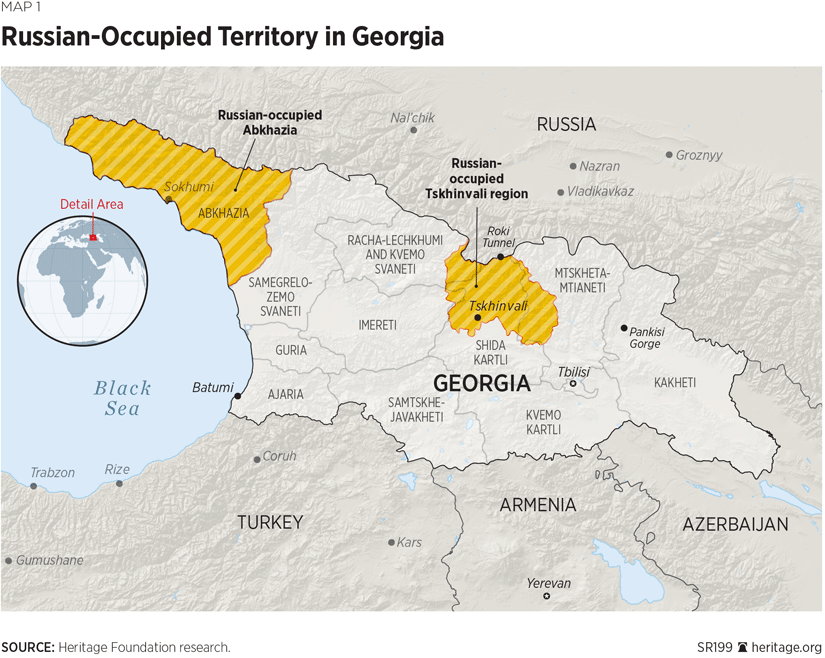
An Important U.S. Ally
After the Russian invasion of Georgia in 2008 and the subsequent occupation of 20 percent of its territory, Georgia has transformed its military and has been steadfast in its support of overseas security operations. Georgia has contributed thousands of troops to Iraq and Afghanistan, and hundreds of peacekeepers to the Balkans and Africa. Even with the Russian invasion and its aftermath, Georgia has not been deterred from getting closer to the West. This has made Georgia a net contributor to transatlantic security.
Georgia is important to the U.S. for three main reasons:
- Georgia is a proven and dependable U.S. ally in places like Iraq and Afghanistan. It is not well-known that at the time of the 2008 Russian invasion, Georgia had the second-largest number of troops in Iraq after the U.S.[REF] In 2012, when many NATO countries were rushing for the door in Afghanistan, Georgia added hundreds of troops to the mission there. At the height of the Georgian contribution to Afghanistan, it had more than 2,000 troops serving in some of the deadliest places in the country, if not the world, in the Helmand and Kandahar provinces. On a per capita basis Georgia has suffered the most killed in combat—even though it has only had a sizeable presence in the country for about half the time of the campaign.[REF] Today, Georgia has 870 troops in Afghanistan, making it the largest non-NATO troop contributor to the NATO training mission.[REF]
- Georgia’s strategic location makes it important for U.S. geopolitical objectives in the Eurasian region. Located in the South Caucasus, Georgia sits at a crucial geographical and cultural crossroads and has proven itself to be strategically important for military and economic reasons for centuries. Today, Georgia’s strategic location is just as important to the U.S. For example, Georgia offered its territory, infrastructure, and logistic capabilities for the transit of NATO forces and cargo for Afghanistan. Over the years, Georgia has modernized key airports and port facilities in the country. This is particularly important when it comes to the Black Sea region. Key pipelines like the Baku–Tbilisi–Ceyhan pipeline, the Baku–Supsa pipeline, and the soon-to-be-operational Southern Gas Corridor transit Georgia as do important rail lines like the recently opened Baku-Tbilisi-Kars railway. The oil and gas pipelines are particularly important to Europe’s energy security, and therefore U.S. national interest in the region.
- Georgia’s journey to democracy is an example for the region. Since regaining independence in 1991 after the collapse of the Soviet Union, Georgia has been on a journey to democracy. For the sake of regional stability, it is in America’s interest that Georgia remain on this path. Over the years, successive Georgian governments have pursued an agenda of liberalizing the economy, cutting bureaucracy, fighting corruption, and embracing democracy. Since the peaceful Rose Revolution in 2003, Georgia has been firmly committed to the transatlantic community. Georgia also represents the idea in Europe that each country has the sovereign ability to determine its own path and to decide with whom it has relations and how and by whom it is governed. Territorial integrity must be respected and no outside actor (in this case, Russia) should have a veto on membership or closer relations with organizations like the European Union or NATO.
Georgia’s fondness for freedom and liberty are nothing new. As the British diplomat and foremost Kartvelian, Sir Oliver Wardrop, wrote in his 1888 book, The Kingdom of Georgia: Travel in a Land of Woman, Wine and Song:
It is interesting to notice that the political ideas of the country are borrowed from Western Europe. Excepting in Japan, perhaps, there is no such instance of a people passing directly from feudalism to liberalism. The grandsons of absolute monarchs, the men who little more than a quarter of a century ago were large slaveholders, are now ardent champions of the democratic idea and loudly proclaim the freedom, the equality, and the brotherhood, of prince and peasant, master and man.[REF]
While decades of Russian and Soviet domination have slowed down democratic progress, Georgia has been quickly making up for lost time since 1991. The U.S. must do everything it can to keep Georgia down the path of economic progress, democracy, and transatlantic and euroatlantic integration.
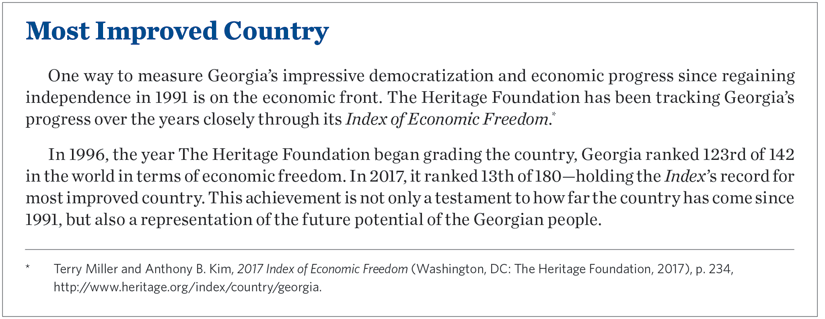
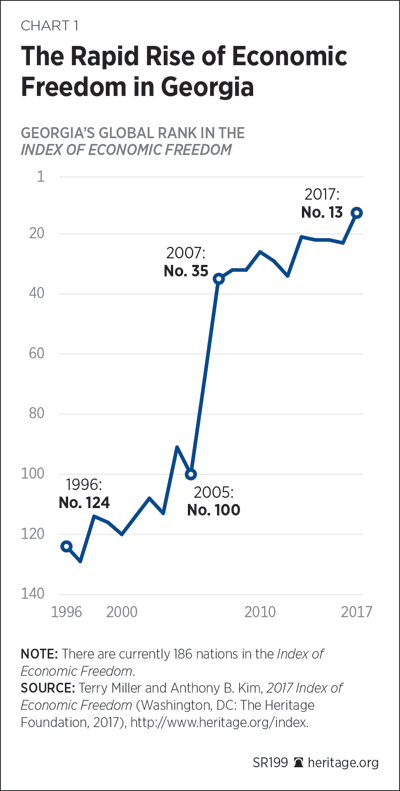
U.S.–Georgian Relationship
The first U.S. diplomatic presence in Georgia was established in 1886 when a U.S. Consulate opened in Batumi.[REF] In 1915, during the early stages of World War I and the threat of the Ottoman invasion of Batumi, the U.S. Consulate was moved to Tbilisi. Of course, during this period Georgia was firmly under the control of the Russian Empire. After the collapse of the Russian Empire in the aftermath of the 1917 Russian Revolution, the newly independent Democratic Republic of Georgia was established from 1918 to 1921. During this brief period of independence, the U.S. did not establish diplomatic relations with Georgia because the State Department was worried about the fallout caused by newly independent states resulting from post-revolutionary Russia. According to then–U.S. Secretary of State Robert Lansing, “[I]t has been thought unwise and unfair to prejudice in advance of the establishment of orderly, constitutional government in Russia, the principle of Russian unity as a whole.”[REF]
Georgia regained its independence on December 25, 1991. Formal diplomatic relations between the U.S. and Georgia were established by President George H. W. Bush on March 24, 1992, and the new American embassy was opened on April 23 of that year.[REF]
Since 1991, the U.S.–Georgian relationship has been multifaceted, focusing on a broad spectrum of issues including democratization, economic reforms, judicial reforms, cultural issues, and business and investment opportunities. Perhaps the area with the biggest impact on the bilateral relationship is in the defense and security field—but even this cooperation did not begin in earnest until 2002 and started with a major focus on counterterrorism operations. This early military cooperation focusing on counterterrorism eventually evolved into preparing Georgia for military operations in Iraq and Afghanistan.
Elements of the U.S. Marine Corps Black Sea Rotational Force often visit Georgia for joint training missions, and U.S. Navy vessels often call into Georgian ports during Black Sea visits. These visits to the Black Sea have been particularly important since Russia’s illegal annexation of Ukraine’s Crimea Peninsula in 2014.[REF] Since this time, Russia has established a robust anti-access/area denial (A2/AD) capability, which threatens NATO and non-NATO partners in the region.
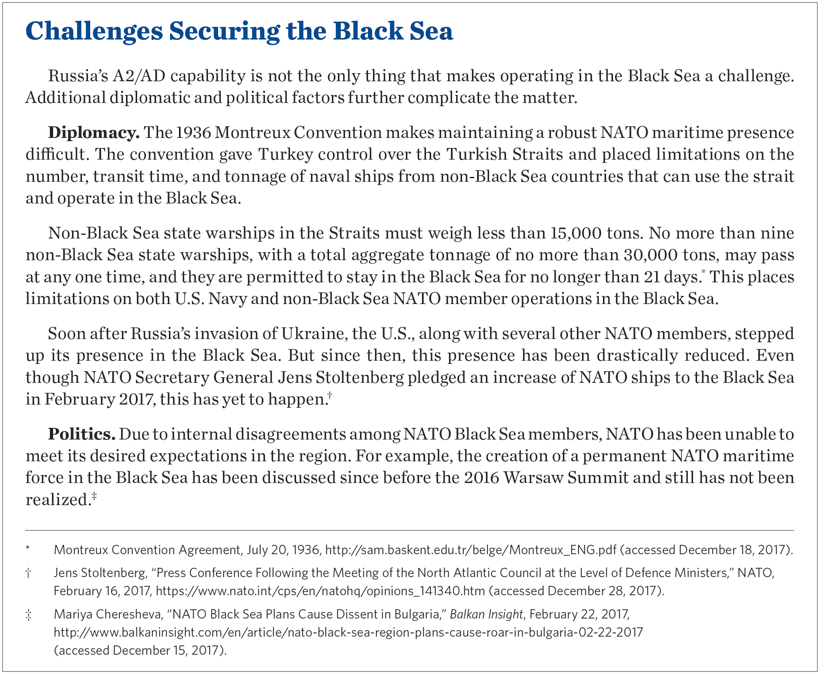
There are two major bilateral annual military exercises that provide the backbone of U.S.–Georgian defense cooperation. In 2011, exercise Agile Spirit began as a bilateral training event to prepare Georgian soldiers deploying to Afghanistan. Today, this exercise invites other European partners to participate. For example, in 2017 more than 1,500 troops from the U.S., Georgia, Azerbaijan, Bulgaria, Latvia, Romania, and Ukraine participated in Agile Spirit.[REF]
The other important bilateral exercise is Noble Partner.[REF] This exercise first started in 2014 and was primarily used to improve Georgia’s interoperability with NATO, train Georgians to NATO standards, and serve as a means to certify Georgia’s contribution to the NATO Response Force. In addition, the (U.S. state) Georgia Army National Guard and the (U.S. state) Georgia Air National Guard annually participate in the exercise. In 2017, Armenia, Germany, Slovenia, Turkey, Ukraine, and the United Kingdom also sent troops.
Throughout these years of defense and security bilateral cooperation, NATO has played a significant role. Some of the most important programs and events in the U.S.–NATO–Georgian relationship include:
- 1994: Georgia joins NATO’s Partnership for Peace program. This program was established in 1991 after the break-up of the Soviet Union and serves as a framework for closer cooperation. The goal is to promote security partnerships between NATO and non-NATO nations in the broader region.
- 1994: State Partnership Program between the U.S. State of Georgia and the Republic of Georgia started. The State Partnership Program started in 1991 and is managed by the National Guard Bureaus. The program pairs U.S. state National Guard units with partner countries to deepen cooperation and improve military capabilities. The Georgia State Partnership Program with the Republic of Georgia is still active today.
- 2002: Georgia Train and Equip Program (GTEP). After 9/11, the U.S. aimed to increase its counterterrorism cooperation around the world. In 2002, Georgia requested assistance from the U.S. to confront internal terrorism threats from Chechen rebels in Georgia’s Panksi Gorge, a small and narrow valley in a region bordering Chechnya about 100 miles from the capital of Tbilisi.
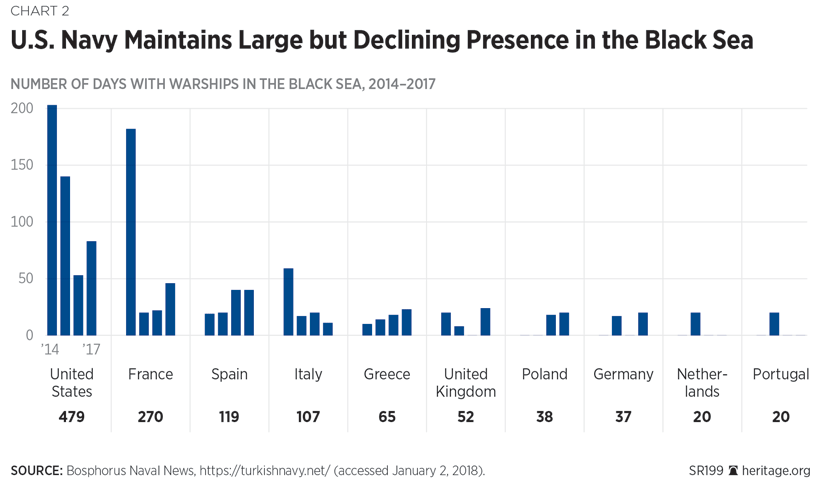
- 2005: Georgia Sustainment and Stability Program started. This training and equipping program helped prepare Georgian troops for deployments to Iraq after the U.S. led the invasion in 2003. Georgia was a committed partner during Operation Iraqi Freedom, with more than 7,800 Georgian troops deploying to Iraq throughout the operation. At the time of the Russian invasion in 2008, Georgia had the second-largest number of troops in Iraq after the United States.
- 2005: Bilateral Defense Consultations established. Bilateral Defense Consultations were created as the primary mechanism to improve ways to deepen U.S.–Georgian bilateral relations. Meetings are held annually and focus on helping Georgia reform its Ministry of Defense and Armed Forces.
- 2008: NATO Bucharest Summit. The Bucharest Summit is considered the beginning of what has become a very long process of Georgia eventually joining NATO. The Summit Declaration stated: “NATO welcomes Ukraine’s and Georgia’s Euro Atlantic aspirations for membership in NATO. We agreed today that these countries will become members of NATO.”[REF]
- 2008: NATO–Georgia Commission (NGC) created. The NGC was established in September 2008 to build on the pledge of eventual NATO membership made earlier in the year during the Bucharest Summit. The NGC serves as a forum for both political consultations and practical cooperation to help Georgia achieve its goal of membership in NATO.[REF]
- 2008: Annual National Program (ANP) begins. The ANP is a tool used by NATO to establish reforms and policy priorities to help aspiring countries on the path to full membership. Since 2008, Georgia has successfully implemented nine cycles of the ANP.[REF]
- 2009: U.S.–Georgia Strategic Partnership Commission established. This program established four high-level working groups to advance the bilateral relationship in: democracy; defense and security; economic, trade, and energy issues; and people-to-people and cultural exchanges.[REF] One of the four working groups includes a Defense and Security Working Group, which meets annually to help deepen U.S.–Georgian security cooperation.
- 2009: Georgian Deployment Program begins. This training and equipping program helped prepare Georgian troops for deployments to Afghanistan as part of the NATO-led operation there. Since 2009, more than 12,000 Georgian troops have served in Afghanistan, and on a per capita basis they have suffered the most combat deaths of any coalition partner.
- 2012: Enhanced Defense Cooperation started. This agreement was built on previous U.S.–Georgian bilateral agreements in the area of defense. The Enhanced Defense Cooperation initiative aimed to help Georgia’s military modernization, increase NATO interoperability, and assist with defense reforms.
- 2014: Substantial NATO–Georgia Package created. At the 2014 NATO summit in Wales, the Alliance agreed to an initiative which expanded NATO’s already close relationship with Georgia. Specifically, 13 programs were established to focus on improving Georgia’s territorial defensive capabilities and prepare Georgia to join NATO. Georgia is the only non-NATO country to have ever received such a package from NATO.
- 2016: Memorandum on Deepening the Defense and Security Partnership between the United States of America and Georgia. To mark the 25th anniversary of Georgia regaining its independence, this memorandum reaffirmed the strategic partnership between the U.S. and Georgia.[REF] This also launched the Georgia Defense Readiness Program, which, for the first time, focused on improving Georgia’s territorial defense capabilities instead of counterinsurgency capabilities needed in Afghanistan.
- 2017: U.S.–Georgia General Security of Information Agreement (GSOIA). The GSOIA agreement marked “a major milestone in security cooperation between the United States and Georgia.”[REF] This agreement improves intelligence sharing between the two countries and opens the door for future agreements on security cooperation and intelligence sharing.
So far, the U.S.–Georgian relationship has thrived under the Trump Administration. Vice President Mike Pence made an early visit to Georgia in the summer of 2017, which was viewed as a major success. Crucially, he referred to the Russian military presence in the Tskhinvali region and Abkhazia as an “occupation.”[REF]
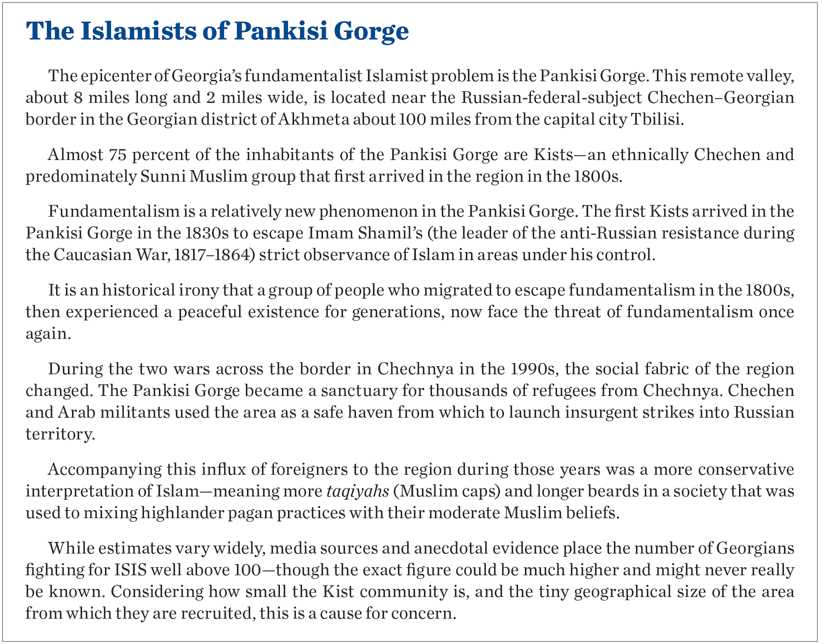
In November 2017, the U.S. announced two very important steps to take the U.S.–Georgian defense relationship to another level. First, the U.S. announced an historic sale of Javelin anti-tank missiles to Georgia. The total package includes 410 missiles and 72 launchers.[REF] The Georgians tried for several years during the Obama Administration to get Javelins from the U.S. with no success. Second, the U.S. agreed at the same time to refocus military cooperation on improving the territorial defense capabilities of the Georgian Armed Forces—a stark change from the years of only training Georgians for counterinsurgency operations in Afghanistan. The Heritage Foundation called for both of these steps to be taken years ago and it welcomes this important and timely move by the Trump Administration.[REF]
The Long Road to NATO
Few countries in Europe express as much enthusiasm for NATO as Georgia—even though it is not yet a member of the Alliance.
NATO’s open-door policy for qualified countries has contributed greatly to transatlantic security since the first round of enlargement in 1952, helping to ensure the Alliance’s central place as the prime guarantor of security in Europe. The North Atlantic Treaty’s Article 10 states that any European state that is “in a position to further the principles of this Treaty and to contribute to the security of the North Atlantic area” may join the Alliance.[REF] There are three official aspirant countries hoping to join NATO: the Republic of Macedonia, Bosnia and Herzegovina, and Georgia.
The NATO–Georgian relationship has never been closer, but more work remains to be done. Georgia was first promised eventual membership at the NATO summit in Bucharest in 2008. Since then, this commitment to membership has been reaffirmed at each subsequent NATO summit. Sadly, not all members of the Alliance have been as supportive as they could be. This is especially true of those NATO members that have an uncomfortably close relationship with Russia.
Georgia’s journey to NATO membership has been a long, and at times, frustrating one.
During the three most recent NATO summits (2012 in Chicago, 2014 in Wales, and 2016 in Warsaw), Georgia had hoped to receive a Membership Action Plan (MAP) but did not. MAP is a NATO program that offers assistance and practical support tailored to the individual needs of countries wishing to join. MAP was first used in 1999, but there is no requirement for a candidate country to either receive or complete a MAP before joining the Alliance. Even though Georgia does not need a MAP to someday join the Alliance, Russia uses the repeated failure of Georgia receiving a MAP from NATO as a propaganda victory.
Even though Georgia has not received a MAP, it has a relationship with NATO that far exceeds the traditional MAP. The relationship includes the Annual National Program, the NATO–Georgia Commission, and the Substantial NATO–Georgia Package. The NATO–Georgia Joint Training and Evaluation Centre (JTEC) was opened in August 2015. Georgia also has twice contributed an infantry company to the NATO Response Force—quite a commitment for a country that is not a member of the Alliance. As NATO Secretary General Jens Stoltenberg said in December 2016: “Georgia has all the practical tools to become a member of NATO.”[REF]
Some NATO members are concerned that Georgia’s entry into NATO would trigger an automatic war with Russia over its occupation of the Tskhinvali Region and Abkhazia. Georgian officials privately say that they are happy to accept a NATO membership arrangement or compromise that excludes the two occupied territories from NATO’s Article 5 security guarantee until the matter is resolved peacefully with the Russians.[REF] To demonstrate its commitment, Georgia made a “non-use of force” pledge regarding the occupied territories that Russia has failed to do.[REF]
As NATO Secretary General Jens Stoltenberg said in December 2016: “Georgia has all the practical tools to become a member of NATO.”
No third party, such as Russia, should have a veto over any decision of the sovereign member states of NATO. Rather, it is for the democratic countries that make up the Alliance to decide on whether to admit new members. All decisions made by the Alliance require unanimity, including those regarding enlargement.
Russia’s Continued Aggression
President Vladimir Putin’s actions are often described as Cold War behavior reminiscent of the Soviet Union. Such a characterization is by and large incorrect: Today, the West is dealing with an imperial Russia, not Soviet Russia. Under Putin’s leadership, Russian policy is more reminiscent of what was seen in the time of the czar before the 1917 Russian Revolution. Putin is an imperial leader—under his leadership Russia is a 21st-century country with 19th-century ambitions. Thanks to his constitutional changes, he has been either prime minister or president of Russia since 1999 and can remain in either one of these positions for as long as he lives.
Therefore, Putin sees Russia’s role in the region through an imperial lens. This is especially true in Georgia. Russia views the South Caucasus as being in its natural sphere of influence and stands ready to exert its influence in the region by military force if necessary.
Russia’s primary strategic goal in Georgia (as it is in Ukraine) is to keep countries which were once under Russian or Soviet domination out of the Western community.
After the war in August 2008, the Geneva International Discussions were established in order to find a diplomatic solution to the invasion. These talks between Russia and Georgia are co-chaired by the European Union, the United Nations, and the Organization for Security and Cooperation in Europe and with participation by the U.S. However, for the most part the Geneva International Discussions talks are gridlocked.
Almost 10 years later Russia is still in violation of two main points of the Six Point Ceasefire Agreement brokered by then–French President Nicolas Sarkozy in August 2008. These two points are:
- Russian military forces must pull back to their locations before the start of hostilities.[REF]
- Russia must provide free access for humanitarian assistance.[REF]
Russia also uses so-called hybrid tactics in Georgia. The 2008 invasion was preceded by a sophisticated cyber attack.[REF] Since the 2008 war Russia has used propaganda, funded nongovernmental organizations, and employed Russian-language TV channels to advance a pro-Russia/anti-West narrative in Georgia.[REF]
Since 2008, the Tskhinvali region and Abkhazia essentially have become large Russian military bases. Thousands of Russian troops are stationed in both regions. Advanced military hardware including armored vehicles, tanks, anti-aircraft batteries, and tactical ballistic missiles are stationed in both the Tskhinvali region and Abkhazia.[REF] Since Georgia’s capital is only 30 miles away from Tskhinvali, all of this is within striking distance of Tbilisi.
The Russian militarization of the Tskhinvali region and Abkhazia is beyond the reach and sight of the European Union Monitoring Mission, established soon after the war to monitor the cease-fire agreement, because Russian authorities prevent it from entering the occupied regions. Even so, in some cases the construction of Russian military facilities can be seen with the naked eye from the Georgian-controlled side of the occupation line.[REF]
Soon after the war in 2008, Russia unilaterally recognized the independence of the two occupied regions. Since then an international drive led by Russia for recognition of the “Republic of South Ossetia” and “Republic of Abkhazia” has been a dismal failure. Out of 193 countries in the United Nations, only four recognize the independence of these illegitimate republics: Russia, Nicaragua, Nauru, and Venezuela. It is worth pointing out that Nauru formally recognized the breakaway regions only after Russia provided it with $50 million in aid in 2009.[REF] In November 2017 the president of Nauru even visited Abkhazia in what the Georgian Ministry of Foreign Affairs described as “a blatant violation of international law.”[REF]
The Russian militarization of the Tskhinvali region and Abkhazia is beyond the reach and sight of the European Union Monitoring Mission.
In the same way that Russia is failing at gaining international recognition of the two breakaway regions, Georgia is having difficulties convincing its Western European allies, even the United Kingdom, to formally recognize Russia’s military presence on its land as an “occupation.”
The two occupied regions depend wholly on Moscow for their security and economic well-being. The Line of Occupation[REF] on the Russian side is patrolled by security officials from the Federal Security Service (commonly referred to as the FSB), which is the successor to the Soviet Union’s KGB.
Since 2011, FSB and separatist forces have implemented a policy of “borderization” in Abkhazia and the Tskhinvali region. This includes constructing illegal fencing and earthen barriers to separate communities and further divide the Georgian population. Russian and Russian-backed forces have also installed “State Border” signs warning those on the Georgian side of the Line of Occupation not to enter. In extreme cases Russia has taken even more territory, often yards at a time, in what has been described as Russia’s “creeping annexation.”[REF] Research carried out by The Heritage Foundation has found 56 incidents at 48 different locations of Russian borderization in Abkhazia and the Tskhinvali region. Russia’s borderization process divides local families and communities.
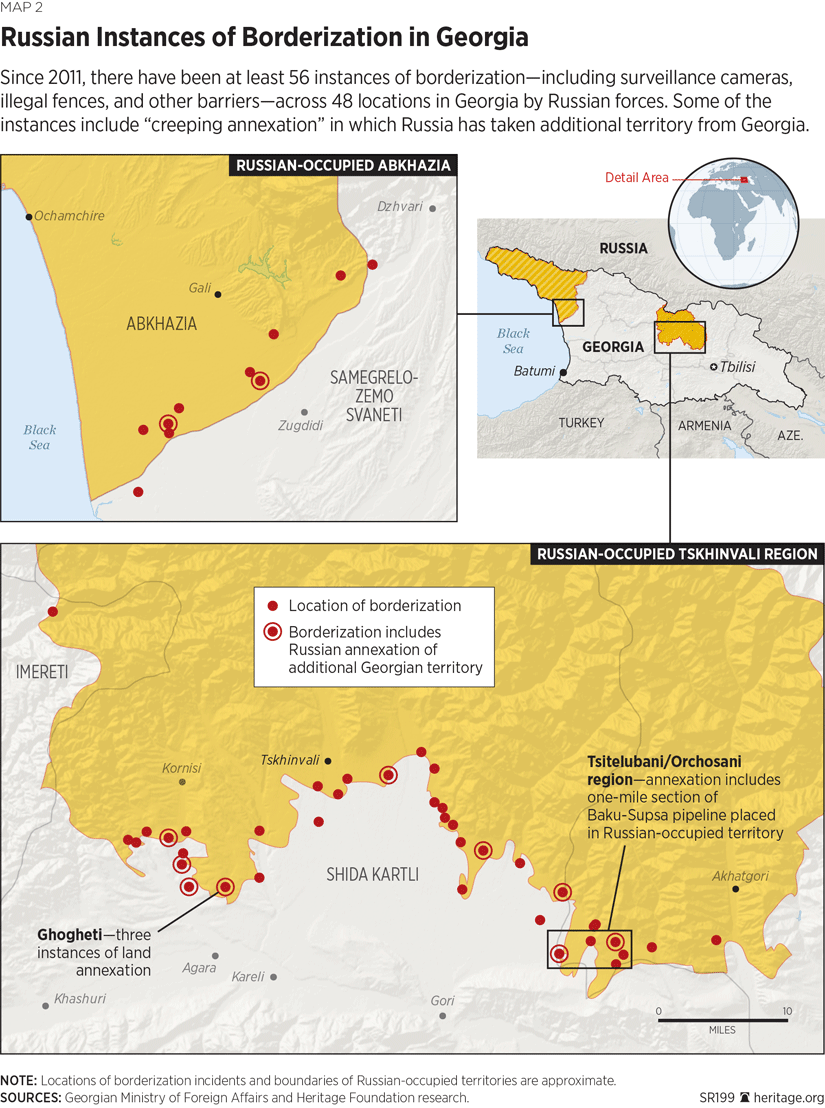
The most egregious example of borderization since the 2008 war took place in July and August 2015, when Russia annexed an additional 300 acres of Georgian territory. During this time Russia built a fence within 550 yards of Georgia’s E60 highway, which is the main road in the South Caucasus linking the Black Sea to Azerbaijan. A “State Border” sign installed by Russian authorities is also visible from the highway. This annexation placed a one-mile segment of the BP-operated Baku-Supsa pipeline inside Russian-occupied territory.[REF]
In 2015, Russia signed so-called integration treaties with the separatist authorities in the Tskhinvali region and Abkhazia. Among other things, these treaties call for a coordinated foreign policy, the creation of a common security and defense space, and the implementation of a streamlined process for Abkhazians and ethnic Ossetians in the Tskhinvali region to receive Russian citizenship. The Georgian Foreign Ministry criticized the treaties as a step toward the “annexation of Georgia’s occupied territories.”[REF] In March 2017, a measure was taken to fully integrate the armed forces of the separatist Tskhinvali region into the Russian military.[REF]
In April 2017, the separatist government in the Tskhinvali region held an illegal referendum to change the name of the breakaway republic from “Republic of South Ossetia” to “State of Alania.” This would bring the name closer in line with the Republic of North Ossetia–Alania, a Russian federal district in the North Caucasus.[REF] This was the idea of the Ossetian separatist leader, Leonid Tibilov, who desires an eventual full integration with Russia’s North Ossetia.[REF]
Another concern for Georgia should be Russia’s increasing military presence in Armenia, and how Moscow might stoke sectarian divisions with the sizable ethnic Armenian minority located in the Georgian province of Samtskhe–Javakheti.
Moscow has a track record of taking advantage of ethnic divisions and tensions in the South Caucasus to advance pro-Russian policies that are often at odds with America’s or NATO’s goals in the region.
Russia maintains a sizable military presence in Armenia based on an agreement giving Moscow access to bases in that country for 49 years.[REF] The bulk of Russia’s forces, consisting of approximately 5,000 soldiers and dozens of fighter planes and attack helicopters, are based around the 102nd Military Base.[REF] Also, Russia and Armenia signed a Combined Regional Air Defense System agreement and maintain some joint military units. Russia has long had difficulty supplying these forces, especially since a transit route which runs right through Georgian airspace has been closed and Turkey refuses transit. This has left reliance on Iran, which for obvious reasons is not ideal for Russia.
The Georgian province of Samtskhe–Javakheti is strategically important for a number of reasons. The Baku–Tbilisi–Ceyhan pipeline and the South Caucasus Pipeline, carrying oil and gas, respectively, from the Caspian to the Mediterranean, pass through the province. The Baku-Tbilisi-Kars railway also runs through Samtskhe–Javakheti. As the possibility of increased Central Asian gas transiting to Europe becomes more likely, these pipelines could become vital for Europe. This is especially true at a time when many European countries are dependent on Russia for their energy resources.
Moscow has a track record of taking advantage of ethnic divisions and tensions in the South Caucasus to advance pro-Russian policies that are often at odds with America’s or NATO’s goals in the region.
Consequently, there is concern that Russia is exploiting ethnic tensions in the ethnic Armenian-populated Samtskhe–Javakheti in order to create a sphere of influence, linking Russia with Armenia through the Tskhinvali region and Samtskhe–Javakheti.
Causing instability or stoking separatist tendencies in Samtskhe–Javakheti would achieve two goals for Moscow. First, it would further dismember the territorial integrity of Georgia and continue to delay Georgia from fully integrating into euroatlantic organizations. With the Tskhinvali region already under Russian occupation, an independent Samtskhe–Javakheti, or one under Russian influence, would divide Georgia down the middle.
Second, and more important for Russia, bringing the region under Moscow’s influence would make a land corridor between Russia and Armenia via the Tskhinvali region one step closer to being a reality.
Armenian separatism in Samtskhe–Javakheti might not be as vocal as it was only a few years ago, but there is still a fear that Moscow could easily re-energize separatist movements in the region. In 2010 Russian Foreign Minister Sergei Lavrov, himself half-Armenian, publicly criticized Georgia’s alleged mistreatment of ethnic minorities, including Armenians.[REF]
Many Javakheti Armenians have Russian sympathies. For example, a large number of Javakheti Armenians hold Armenian passports, making it easier to find seasonal work in Armenia and Russia.[REF] (Since the Russian ruble has lost much of its value due to economic sanctions, remittances have also decreased, adding to the already existing economic problems). Until its closure in 2007, the Russian military base there was the single largest source of employment. There is also a concern by many ethnic Armenians about a decrease in the quality of education among the Javakheti Armenian population because there are not enough qualified teachers with proficiency in both Georgian and Armenian.[REF] Part of this problem is the unwillingness of the ethnic Armenian population to learn Georgian.
In September 2017, there was a clash between the Georgian police and ethnic Armenians in the Samtskhe–Javakheti village of Kumurdo. The dispute was over whether renovations being undertaken at the village’s 10th-century church disregarded the bodily remains of Armenians buried in the church yard.[REF]
Clearly, under the right circumstances Russia could exploit local and sectarian divisions and stir up unrest with Georgia’s Armenian minority to further advance its own agenda in the South Caucasus.
Deepening the Relationship
Georgians have proven themselves reliable U.S. allies and gallant in combat. They are also undertaking a defense transformation program and investing in their military in a way far exceeding NATO’s standard. The Georgian population has shown a commitment to the transatlantic community and more enthusiasm for NATO than most of the Alliance’s current members.
The year 2018 offers the U.S. an opportunity to deepen its relationship with Tbilisi, reaffirm NATO’s commitment to Georgian membership, strengthen the NATO–Georgian relationship, boost Georgia’s NATO integration process, and enhance Georgia’s defensive capabilities. In the long run, this would bring more stability to the South Caucasus and Black Sea regions, which is in America’s national interest.
In order to advance U.S. interests in the South Caucasus and Black Sea regions and deepen the bilateral relationship with Georgia, the U.S. should:
- Keep up a visible political presence in Georgia. Vice President Pence’s visit last summer was a great first step. This visit should be followed by a presidential visit and regular Cabinet-level visits to deepen cooperation in diplomatic, economic, defense, cultural, and energy fields.
- Push Russia to live up to the commitments in the 2008 Six Point Ceasefire Agreement. It is utterly unacceptable that almost 10 years later Russia still does not fully abide by the cease-fire agreement. The U.S. should work with allies to pressure Russia to allow international monitors and humanitarian aid into the occupied regions and to pull back Russian forces to their pre-August 2008 locations.
- Supply anti-aircraft and air defense weapons to Georgia. Every country has the right to self-defense. While the decision to provide anti-tank weapons is welcome and a good first step, more can be done to enhance the defensive capabilities of Georgia. This includes helping Georgia defend its airspace and territory from hostile planes and missiles.
- Encourage, where possible, countries to refuse recognition of independence of the two Russian-occupied regions of Georgia. Countries siding with Russia should be strongly encouraged to change their policy to coincide with mainstream international opinion and recognize the Tskhinvali region and Abkhazia as part of Georgia’s territory. In particular the U.S. has leverage it can use with Nicaragua (millions of dollars in aid money) and Narau (the expanded ship-rider agreement as part of the Oceania Maritime Security Initiative) to encourage a change in policy.[REF]
- Push for Georgia’s speedy membership in NATO by temporarily amending Article 6 of the 1949 North Atlantic Treaty. Many are worried that Georgia’s NATO membership will mean automatic war with Russia over the occupied regions. Georgia can be invited to join NATO by amending Article 6 of the 1949 North Atlantic Treaty (which defines which territories fall under the Article 5 protection) to temporarily exclude the Russian-occupied Tskhinvali region and Abkhazia from Article 5 protection. This amendment can be made with Georgia’s accession protocol as it was in 1951 when Turkey and Greece joined the Alliance. It is important to point out that this would only be a temporary measure until Georgia’s full, internationally recognized territory is re-established by peaceful and diplomatic means at a future date. Allowing Georgia to join NATO with an amended Article 6 is also consistent with Georgia’s non-use-of-force pledge regarding regaining control of the occupied regions. This would allow Georgia to join NATO more quickly and would deny Moscow’s de facto veto on countries under partial Russian occupation that want to join the Alliance.
- Develop a strategy for the Black Sea region. The Black Sea sits at an important crossroads between Europe, Asia, and the Caucasus. Since Russia’s illegal annexation of Crimea, the Black Sea has essentially become a Russian lake. This is a direct threat to U.S., NATO, and Georgian security interests. Many of the recent initiatives at the NATO level have not met expectations. The U.S. should be a leader inside the Alliance to develop meaningful ways to work with the Black Sea littoral states to develop a strategy for regional security.
- Work with NATO to open a NATO-certified Center of Excellence on Black Sea Security in Georgia. There is no precedent for a NATO-certified Center of Excellence in a non-NATO country; but establishing one could improve NATO–Georgia relations and show how important the Black Sea region has become for Europe’s overall security. The Center of Excellence would provide an opportunity to engage in meaningful dialogue and training in how to address the challenges associated with Black Sea security.
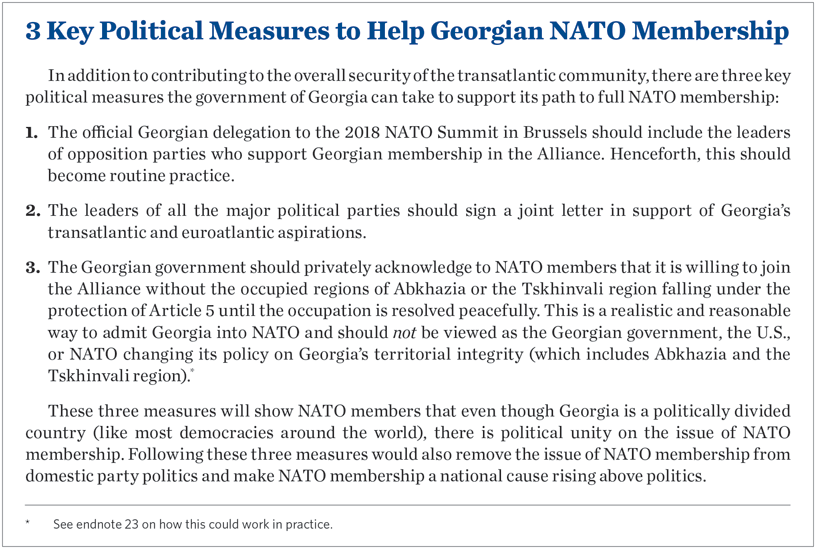
- Work with NATO to establish a Black Sea Maritime Patrol mission modeled off the Baltic Air Policing mission. NATO’s interest in Black Sea security is increasing, but the overall presence of non–Black Sea NATO warships is decreasing. NATO should establish a Black Sea Maritime Patrol mission modeled on the successful Baltic Air Policing mission, in order to maintain a robust NATO presence in the Black Sea in line with the 1936 Montreux Convention. This would require non–Black Sea NATO countries to commit in advance to a regular and rotational maritime presence in the Black Sea.
- Push the Alliance to publish a separate summit declaration on the Black Sea. NATO leaders often agree on separate declarations, in addition to the main declaration, regarding specific issues of importance. Since the Black Sea is a very important region for NATO, and has not received the attention it deserves, a separate declaration on NATO’s strategy and support for countries in the Black Sea would send a message that the Alliance takes the region seriously.
- Invite Georgia to contribute troops to the U.S.-led multinational battalion in Poland as part of NATO’s Enhanced Forward Presence. Georgians are always looking for new ways to contribute to transatlantic security and the U.S. and Georgia have a strong track record serving alongside each other. The U.S. should invite Georgia to contribute to its multinational battalion in Poland. To date, no non-NATO ally has contributed troops as part of the Enhanced Forward Presence initiative, but if Georgian troops are able to serve in the NATO Response Force they should also be able to serve as part of the Enhanced Forward Presence.
- Focus NATO’s Centers of Excellence on the security situation in Georgia and the South Caucasus. NATO should encourage NATO’s Centers of Excellence to assist Georgia in facing Russian aggression, especially at the centers focusing on cyberspace (Estonia), energy security (Lithuania), and countering propaganda (Latvia). Even as an aspirant country the Alliance should consider inviting Georgia to become a Contributing Participant in each of these three centers.
- Push NATO to refer to the Russian military presence as an occupation. In the upcoming NATO Summit declaration, NATO should call the presence of several thousand Russian troops in the Tskhinvali region and Abkhazia what it is: an occupation. Short of this, the declaration should at least include a footnote listing all the countries that recognize the Russian military presence in Georgia as an occupation. To date, many European countries have failed to use this terminology. Given recent events in Crimea and eastern Ukraine, it is more important than ever that NATO send a united and clear message.
- Make it clear that a Membership Action Plan is not required for NATO membership. It is a common misconception that a MAP is a requirement for joining the Alliance, and the U.S. should use the upcoming summit to clear up any confusion on this matter. NATO members should not use this technicality as a road block for Georgia’s future membership. With the Annual National Program, the NATO–Georgia Commission, and the Substantial NATO–Georgia Package, Georgia’s relationship with NATO is closer now than it would have been under the traditional MAP.
- Ensure that the NATO–Georgia Commission meeting takes place at the heads-of-state or government level. Currently, this meeting is planned for the foreign-ministers level. This sends the wrong signal to the Georgian people. The NATO–Georgian Commission should be held at the heads-of-state or government level to demonstrate the importance with which NATO views its relationship with Georgia.
- Ensure that the Alliance is clear on Georgia’s future membership. The summit declaration should make it clear that Georgia’s successful completion of subsequent Annual National Programs, the close relationship through the NATO–Georgia Commission, and the Substantial NATO–Georgia Package are the true markers of progress that will bring Georgia closer to membership.
- Ensure that the Substantial NATO–Georgia Package (SNGP) is fully resourced. While the SNGP has done a lot to improve the capabilities of the Georgian Armed Forces, full implementation of the package has been slow and incomplete. NATO should ensure that the resources are dedicated to fulfill the complete package in a timely manner.
- Agree to a package of conditional economic sanctions that will trigger automatically if either Abkhazia or the Tskhinvali region is annexed by Russia. The U.S. should make it very clear to Russia that annexation of either of the breakaway regions will trigger stronger economic sanctions that target key Russian officials. The U.S. should start now to develop a strategy with its European partners to prepare for this possibility.
- Offer political support for the Southern Gas Corridor project. As Europe seeks alternatives to Russian gas, the Southern Gas Corridor, which in part will run through Georgia and the Balkans, will play an important role. The U.S. should offer political support to this project in the same way it did to the construction of the Baku–Tbilisi–Ceyhan Pipeline in the 1990s.
- Push for a free trade agreement with Georgia. While the Georgian economy is relatively small, a U.S.–Georgia free trade agreement would have a geopolitical impact. It would send a message to the region, friend and foe alike, that the U.S. is a key player and serious about deepening relations with a deserving country like Georgia.
- Consider using Georgia as a transit route for Afghanistan. A key plank of the Administration’s Afghan strategy is pressuring Pakistan to end its support for the Taliban and associated groups. A consequence of this approach with Islamabad might be that the ground and air resupplies transiting Pakistani territory could be cut or stopped all together. The transit route through Georgia and Azerbaijan could offer one of the shortest and most cost-effective routes to bypass both Russia and Pakistan. Most important, it would reduce America’s dependence on Moscow and Islamabad for moving military resources in and out of Afghanistan.
A Great Opportunity
The year 2018 offers many opportunities for deepening the U.S.–Georgian relationship while helping Georgia on the path to NATO membership. Georgia is a staunch ally of the U.S. and NATO. It is located in a dangerous neighborhood, and Russia poses a constant threat. Nevertheless, Georgia has been able to implement serious defense reforms and continues to participate in security operations at a rate much higher than that of many NATO members.
The U.S. must be a leader within NATO to push for a united voice condemning Russian aggression against Georgia, reiterating the need for a complete restoration of Georgia’s territorial integrity. The Trump Administration and the U.S. Congress should not hesitate to provide military and political support for Georgia. The U.S. should seize the opportunity to quickly and robustly reaffirm American commitment and support for the people of Georgia in 2018. This will make both America and her allies safer.
—Luke Coffey is Director of the Douglas and Sarah Allison Center for Foreign Policy, of the Kathryn and Shelby Cullom Davis Institute for National Security and Foreign Policy, at The Heritage Foundation. The author is grateful to Alexis Mrachek, Research Assistant for Russia and Eurasia, for her invaluable help preparing this Special Report.
Appendix: 56 Instances of Russia–Georgia “Borderization”
Tskhinvali Region
2011
- April–May: Villages of Tamarasheni, Dvani, Didi Khurvaleti, and Kveshi—barbed-wire fences installed[REF]
2012
- March–May: Village of Mejvriskhevi—barbed-wire fences installed
2013
- March–May: Villages of Kvemo Nikozi and Gugutiantkari—barbed-wire fences installed
- March–May: Didi Khurvaleti village—more barbed-wire fences installed beyond initial occupation line
- March–May: Villages of Atotsi, Tamaresheni, and Dvani—barbed-wire fences installed
- May: Villages of Knolevi, Avlevi, and Tseronisi—metal fencing installation process launched
- May: Village of Dits’i—five-foot iron poles installed approximately 130 yards to 165 yards inside the Georgian-controlled territory
- June–August: Area around villages of Meret’i and K’suisi—metal fences installed
- June–August: Village of Sakorintlo—metal fences installed
- June–August: Area around villages of Tvaurebi and Akhmaji—barbed-wire fences installed
- June: Village of Mejvriskhevi—more barbed-wire fences installed; fences equipped with supposed motion detectors
- July: Village of Dits’i—existing iron poles connected with barbed wire to create fences
- August: Villages of Dirbi and Jariasheni—barbed-wire fences installed
- September: Village of Dits’i—more barbed-wire fences installed
- September: Village of Dvani—more barbed-wire fences and artificial obstacles installed
- November: Villages of Knolevi, Avlevi, Tseronisi, Tamarasheni, Ghogheti, Dirbi, Dvani, Ergneti, Dits’i, Kere, P’lavi, Plavismani, Mejvriskhevi, Tsitsagiantkari, and Zemo Nikozi—sign posts indicating the “State Border” installed. In Ghogheti, 69 acres of agricultural land now appear on the Russian-occupied side of the occupation line.
- November: Villages of Tvaurebi and Akhmaji—existing metal fences equipped with motion detectors and video cameras
- November: Villages of Dits’i and Ergneti—metal fence originally installed in Dits’i now reaches Ergneti
- November: Village of Ghogheti—more metal fences installed
- November: Village of Dvani—more barbed-wire fences installed
- December: Village of Bershuet’i—barbed-wire and metal fences installed
- December: Villages of Knolevi, Avlevi, and Tseronisi—metal fences installed between each of the three villages
- December: Villages of P’lavi and Plavismani—barbed-wire fence and additional “State Border” signs installed[REF]
- December: Village of Ghogheti—more metal fences installed. Approximately 37 acres of Georgian-controlled land now appear on the Russian-occupied side of the barbed wire.[REF]
- December: Village Dvani—more barbed-wire and metal fences installed
- December: Villages Koda–Tsnelisi—barbed-wire fence installed
2014
- February: Village of Ghogheti—more metal fences installed. Nearly 69 acres of agricultural land controlled by Georgia now appear on the Russian-occupied side of the barbed wire.
- February: Village of Atotsi—more metal fences installed. Nearly 30 acres of agricultural and 37 acres of pasturing lands controlled by Georgia now appear on the Russian-occupied side of the barbed wire.
- June: Area between the villages of Kere and Otrevi—metal pylons and barbed wire installed along with motion detectors
- September–November: Villages of Knolevi, Avlevi, Tseronisi, Tamarasheni, Ghogheti, Dirbi, and Dvani villages—“State Border” signs installed 2015
- February: Village of Jariasheni—barbed-wire fence moved 38 yards into territory controlled by Georgia[REF]
- July: Territory adjacent to villages of Tsitelubani and Orchosani—“State Border” signs installed. Nearly 148 acres of land controlled by Georgia now appear on the Russian-occupied side of the barbed wire. In addition, nearly one mile of the Baku-Supsa pipeline now appears in the occupied territory.
- August: Territory adjacent to villages of Tamarasheni and Tseronisi—additional “State Border” signs and barbed-wire fences installed. In total, 143 acres of land controlled by Georgia now appear on the Russian-occupied side of the barbed wire.[REF]
- October: Vicinity of village of Kardzmani—“State Border” signs installed
2016
- March: Village of Jariasheni—land-leveling by Russian occupation forces to construct a roadway, considered a “softer” border than a fence. The newly leveled land enters into the Georgian government’s territory as deep as 16 yards.
- June: Territory adjacent to village of Avlevi—more “State Border” signs installed
- June: Area adjacent to villages of Tsitelubani and Khurvaleti—more “state border” signs installed
- June: Area adjacent to village of Bershuet’i—“State Border” signs installed
- June: Vicinity of the village Karapila—“State Border” signs installed
- August: Village of Knolevi—observation tower installed
2017
- June: Area between villages of Dvani and Nikozi—land-leveling to construct a roadway along the line of occupation
- June: Line of occupation from Ghogheti to Tamarasheni—land-leveling to construct a roadway along the line of occupation
- June: Line of occupation from Tamarasheni to Knolevi—land-leveling to construct a roadway along the line of occupation
- July: Village of Karapila—“State Border” signs installed[REF]
- July: Area near Bershuet’i—“State Border” signs installed. An additional 25 acres of land controlled by Georgia now appear on the Russian-occupied side of the barbed wire.[REF]
- July: Line of occupation from villages of Kvemo Sobisi to Tsitelubani and Khurvaleti—land-leveling to construct a roadway along the line of occupation
- July: Area adjacent to occupation line from villages of Kurtayev to Dzukata—land-leveling to construct a roadway along the line of occupation
- July: Line of occupation from villages of Orchosani to Karapila—land-leveling to construct a roadway along the line of occupation
- October: Villages of Chvirnisi and Koda—metal fences installed
- October: Villages of Gugutiantkari and Zardiantkari—“State Border” signs installed
Abkhazia Region
2013
- June: Villages of Otobaia, Ganmukhuri, Orsantia, Nabakevi, Khureha, Tugiloni, Shamgona, and Chuburkhinji—miles of ditches and embankments are dug
- December: Villages of Pakhulani and Saberio—barbed-wire fences installed
- December: Village of Orsantia—barbed-wire fence installed on major bridge
2017
- April: Villages of Orsantia and Otobaia—approximately 40 observation cameras installed by Russian occupation forces
- April: Area adjacent to villages of Khurcha and Shamgona—several wooden pylons installed along the occupation line
- August: Area adjacent to Khurcha and Shamgona—barbed-wire added to existing wooden pylons along the occupation line. Nearly five acres of land controlled by Georgia now appear on the Russian-occupied side of the barbed wire.
Source: Unless otherwise specified in footnotes 47–53, the information comes from the Georgian Ministry of Foreign Affairs.
Italic indicates cases of borderization that resulted in additional Georgian territory falling under Russian occupation.


